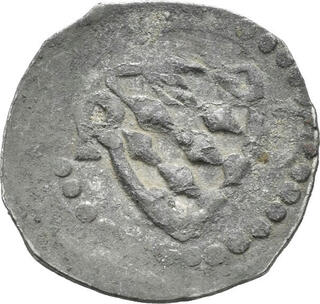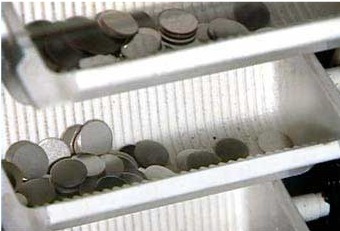|
Schüsselpfennig
A Schüsselpfennig ("dish ''pfennig''"), also ''Gehulchter Pfennig'' ("hollow ''pfennig''") is so called due to the stamping technique which results in a concave, one-sided type of ''Pfennig'' coin. It was probably first minted in 1374 in the Palatinate. Small ''Schüsselpfennigs'' that had entered the Electorate of Saxony were referred to there as ''Näpfchenheller'' ("saucer ''hellers''"). History The ''Schüsselpfennig'' was widespread and can even be found in dictionaries described as a "small one-sided pfennig made of silver with a rim that is curved upwards like a dish". It was manufactured by minting using only one, upper, stamp on a larger planchet. When the ''pfennig'' was stamped, its edge was pressed upwards in the shape of a bowl or dish. The convex shape of the ''pfennigs'' proved to be very practical in payment transactions because the small coins were easier to grip than their flat counterparts. The forerunners of the ''Schüsselpfennigs'' were the one-sided ... [...More Info...] [...Related Items...] OR: [Wikipedia] [Google] [Baidu] |
Schüsselpfennig Um 1400 Pfalz
A Schüsselpfennig ("dish ''pfennig''"), also ''Gehulchter Pfennig'' ("hollow ''pfennig''") is so called due to the stamping technique which results in a concave, one-sided type of ''Pfennig'' coin. It was probably first minted in 1374 in the Palatinate. Small ''Schüsselpfennigs'' that had entered the Electorate of Saxony were referred to there as ''Näpfchenheller'' ("saucer ''hellers''"). History The ''Schüsselpfennig'' was widespread and can even be found in dictionaries described as a "small one-sided pfennig made of silver with a rim that is curved upwards like a dish". It was manufactured by minting using only one, upper, stamp on a larger planchet. When the ''pfennig'' was stamped, its edge was pressed upwards in the shape of a bowl or dish. The convex shape of the ''pfennigs'' proved to be very practical in payment transactions because the small coins were easier to grip than their flat counterparts. The forerunners of the ''Schüsselpfennigs'' were the one-sided ... [...More Info...] [...Related Items...] OR: [Wikipedia] [Google] [Baidu] |
Pfennig
The 'pfennig' (; . 'pfennigs' or ; symbol pf or ₰) or penny is a former German coin or note, which was the official currency from the 9th century until the introduction of the euro in 2002. While a valuable coin during the Middle Ages, it lost its value through the years and was the minor coin of the Mark currencies in the German Reich, West and East Germany, and the reunified Germany until the introduction of the euro. Pfennig was also the name of the subunit of the Danzig mark (1922–1923) and the Danzig gulden (1923–1939) in the Free City of Danzig (modern Gdańsk, Poland). Overview Name The word ''Pfennig'' (replacing the ''denarius'' or ''denarius'' as a low-denomination silver coin) can be traced back to the 8th century and also became known as the ''Penning'', ''Panni(n)g '', ''Pfenni(n)c'', ''Pfending'' and by other names, e.g. in Prussia until 1873, ''Pfenning''. The ''-ing''- or ''-inc'' suffix was used, in addition to ''-ung'', the formation of affil ... [...More Info...] [...Related Items...] OR: [Wikipedia] [Google] [Baidu] |
Weckeler
The ''Weckeler'', also called a ''Weckelerpfennig'', is a one-sided silver Palatine ''pfennig'' coin of the 14th and 15th century, which was also called the ''Wegkpfennig'' in the local dialect. It occurs both as a ''Schüsselpfennig'' and as a non-domed, planar coin. The ''pfennigs'' were given their contemporary name after their image, a lozenged coat of arms. This ''pfennig'', with its ring of pearls around a central lozenged shield or just a lozenge without a shield, developed into the bowl-shaped ''Schüsselpfennig'' in the 15th century. The ''Weckeler'' was struck on one side only using a coin die smaller than the actual planchet A planchet is a round metal disk that is ready to be struck as a coin. An older word for planchet is flan. They are also referred to as blanks. History The preparation of the flan or planchet has varied over the years. In ancient times, the f .... The force of the die stamp caused the perimeter of the planchet to curve upwards to a gr ... [...More Info...] [...Related Items...] OR: [Wikipedia] [Google] [Baidu] |
Planchet
A planchet is a round metal disk that is ready to be struck as a coin. An older word for planchet is flan. They are also referred to as blanks. History The preparation of the flan or planchet has varied over the years. In ancient times, the flan was heated before striking because the metal that the coin dies were made of was not as hard as dies today, and the dies would have worn faster and broken sooner had the flan not been heated to a high temperature to soften it. An unusual method was used to mint the one-sided, bowl-shaped ''pfennigs'' of the Holy Roman Empire. The planchet used for these so-called ''Schüsselpfennigs'' was larger than the coin die itself. The coins were made by striking with only one upper die on the larger planchet. As a result, the perimeter of the planchet was pressed upwards in the shape of a bowl or plate. Until the 18th century they were minted mainly in the Harz Mountains. The curved shape of the pfennig was very useful for handling small change ... [...More Info...] [...Related Items...] OR: [Wikipedia] [Google] [Baidu] |
Lilienpfennig
The Lilienpfennig was a type of Late Medieval ''pfennig'' from the German Free Imperial City of Strasbourg which was stamped on one side with the image of a fleur-de-lys. These silver ''pfennigs'' were the forerunners of the bowl-shaped ''Schüsselpfennig'' and were struck from the beginning of the 14th century. They had a diameter of 14 to 17 mm and weighed about 0.32 to 0.45 g. The ''Lilienpfennigs'' were one of the so-called 'eternal ''pfennigs (''Ewiger Pfennig'') because, unlike most bracteates, they did not have to be exchanged regularly for a fee.Kahnt (2005), p. 429 The planchet used for striking the coin was larger than the coin die itself, resulting in a broad, unstamped perimeter that bent up like a plate due to the die pressure. These small convex coins were easier to handle in payment transactions than their small flat-faced counterparts. It is also recorded that the upturned rim was a protection against clipping at that time. The small balls in the design of the he ... [...More Info...] [...Related Items...] OR: [Wikipedia] [Google] [Baidu] |
Bracteate
A bracteate (from the Latin ''bractea'', a thin piece of metal) is a flat, thin, single-sided gold medal worn as jewelry that was produced in Northern Europe predominantly during the Migration Period of the Germanic Iron Age (including the Vendel era in Sweden). Bracteate coins are also known from the medieval kingdoms around the Bay of Bengal such as Harikela and Mon city-states. The term is also used for thin discs, especially in gold, to be sewn onto clothing in the ancient world, as found for example in the ancient Persian Oxus treasure, and also later silver coins produced in central Europe during the Early Middle Ages. Gold bracteates from the Migration Period Gold bracteates commonly denote a certain type of jewelry, made mainly in the 5th to 7th century AD, represented by numerous gold specimens. Bead-rimmed and fitted with a loop, most were intended to be worn suspended by a string around the neck, supposedly as an amulet. The gold for the bracteates came from coins pa ... [...More Info...] [...Related Items...] OR: [Wikipedia] [Google] [Baidu] |
Canton Of St
Canton may refer to: Administrative division terminology * Canton (administrative division), territorial/administrative division in some countries, notably Switzerland * Township (Canada), known as ''canton'' in Canadian French Arts and entertainment * Canton (band), an Italian synth pop group * "Canton" (song) by Japan * Canton, a fictional town in " Jaynestown", an episode of ''Firefly'' Design * Canton (building), a corner pilaster * Canton (flag), an emblem placed in the top left quarter of a flag * Canton (heraldry), a square or other charge (symbol) occupying the upper left corner of a coat of arms * Canton porcelain, Chinese ceramic ware People * Canton (surname), and list of people with the surname * Canton Jones, American Christian music/hip-hop artist Places Canada * Canton, New Brunswick, a community in Drummond Parish, New Brunswick * Canton, Ontario China * Guangdong (Canton Province), province in southern China * Guangzhou (Canton City), capita ... [...More Info...] [...Related Items...] OR: [Wikipedia] [Google] [Baidu] |
Collection Bag
The offertory (from Medieval Latin ''offertorium'' and Late Latin ''offerre'') is the part of a Eucharistic service when the bread and wine for use in the service are ceremonially placed on the altar. A collection of alms (offerings) from the congregation, which may take place also at non-Eucharistic services, often coincides with this ceremony. The Eucharistic theology may vary among those Christian denominations that have a liturgical offertory. In the Roman Rite, the term "Preparation of the Gifts" is used in addition to the term "Offertory" (both capitalized) or, rather, the term "Preparation of the Gifts" is used for the action of the priest, while the term "Offertory" is used for the section of the Mass at which this action is performed in particular when speaking of the accompanying chant. In Baptist churches, the offertory refers to the part of the service of worship in which collection plates or baskets are distributed by ushers, with the tithes and offerings subseque ... [...More Info...] [...Related Items...] OR: [Wikipedia] [Google] [Baidu] |
House Of Leiningen
The House of Leiningen is the name of an old German noble family whose lands lay principally in Alsace, Lorraine, Saarland, Rhineland, and the Palatinate. Various branches of this family developed over the centuries and ruled counties with Imperial immediacy. Origins The first count of Leiningen about whom anything definite is known was a certain Emich II (d. before 1138). He (and perhaps his father Emich I) built Leiningen Castle, which is now known as "Old Leiningen Castle" (German: ''Burg Altleiningen''), around 1100 to 1110. Nearby Höningen Abbey was built around 1120 as the family's burial place. This family became extinct in the male line when Count Frederick I died about 1220. Frederick I's sister, Liutgarde, married Simon II, Count of Saarbrücken. One of Liutgarde's sons, also named Frederick, inherited the lands of the counts of Leiningen, and he took their arms and their name as Frederick II (d. 1237). He became known as a ''Minnesinger'', and one of his songs w ... [...More Info...] [...Related Items...] OR: [Wikipedia] [Google] [Baidu] |




.jpg)
